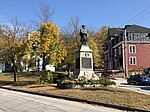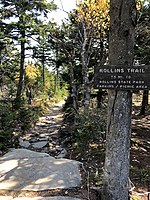New Hampshire Telephone Museum
History museums in New HampshireMuseums established in 2005Museums in Merrimack County, New HampshireTelecommunications museums in the United StatesTelephone museums

The New Hampshire Telephone Museum is a nonprofit, telecommunications history museum in Warner, New Hampshire, in the United States. There are over 1,000 telephone-related artifacts in the museum. The museum features switchboards, a large display of rotary phones, candlestick telephones, wooden wall-mount phones, phone booths, princess phones, flip phones and smart devices. Public programs include guided tours, lectures, interactive displays suitable for all ages.
Excerpt from the Wikipedia article New Hampshire Telephone Museum (License: CC BY-SA 3.0, Authors, Images).New Hampshire Telephone Museum
Depot Street,
Geographical coordinates (GPS) Address Phone number Website Nearby Places Show on map
Geographical coordinates (GPS)
| Latitude | Longitude |
|---|---|
| N 43.279722222222 ° | E -71.815 ° |
Address
New Hampshire Telephone Museum
Depot Street 1
03278
New Hampshire, United States
Open on Google Maps







